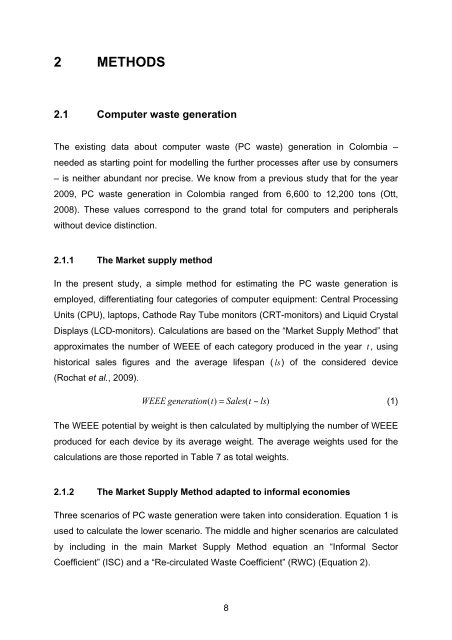10 07 29 Master thesis Juliana Leon - e-Waste. This guide
10 07 29 Master thesis Juliana Leon - e-Waste. This guide
10 07 29 Master thesis Juliana Leon - e-Waste. This guide
Create successful ePaper yourself
Turn your PDF publications into a flip-book with our unique Google optimized e-Paper software.
2 METHODS<br />
2.1 Computer waste generation<br />
The existing data about computer waste (PC waste) generation in Colombia –<br />
needed as starting point for modelling the further processes after use by consumers<br />
– is neither abundant nor precise. We know from a previous study that for the year<br />
2009, PC waste generation in Colombia ranged from 6,600 to 12,200 tons (Ott,<br />
2008). These values correspond to the grand total for computers and peripherals<br />
without device distinction.<br />
2.1.1 The Market supply method<br />
In the present study, a simple method for estimating the PC waste generation is<br />
employed, differentiating four categories of computer equipment: Central Processing<br />
Units (CPU), laptops, Cathode Ray Tube monitors (CRT-monitors) and Liquid Crystal<br />
Displays (LCD-monitors). Calculations are based on the “Market Supply Method” that<br />
approximates the number of WEEE of each category produced in the year t , using<br />
historical sales figures and the average lifespan ( ls) of the considered device<br />
(Rochat et al., 2009).<br />
€<br />
WEEE generation(t) = Sales(t € − ls) (1)<br />
The WEEE potential by weight is then calculated by multiplying the number of WEEE<br />
produced for € each device by its average weight. The average weights used for the<br />
calculations are those reported in Table 7 as total weights.<br />
2.1.2 The Market Supply Method adapted to informal economies<br />
Three scenarios of PC waste generation were taken into consideration. Equation 1 is<br />
used to calculate the lower scenario. The middle and higher scenarios are calculated<br />
by including in the main Market Supply Method equation an “Informal Sector<br />
Coefficient” (ISC) and a “Re-circulated <strong>Waste</strong> Coefficient” (RWC) (Equation 2).<br />
8
















